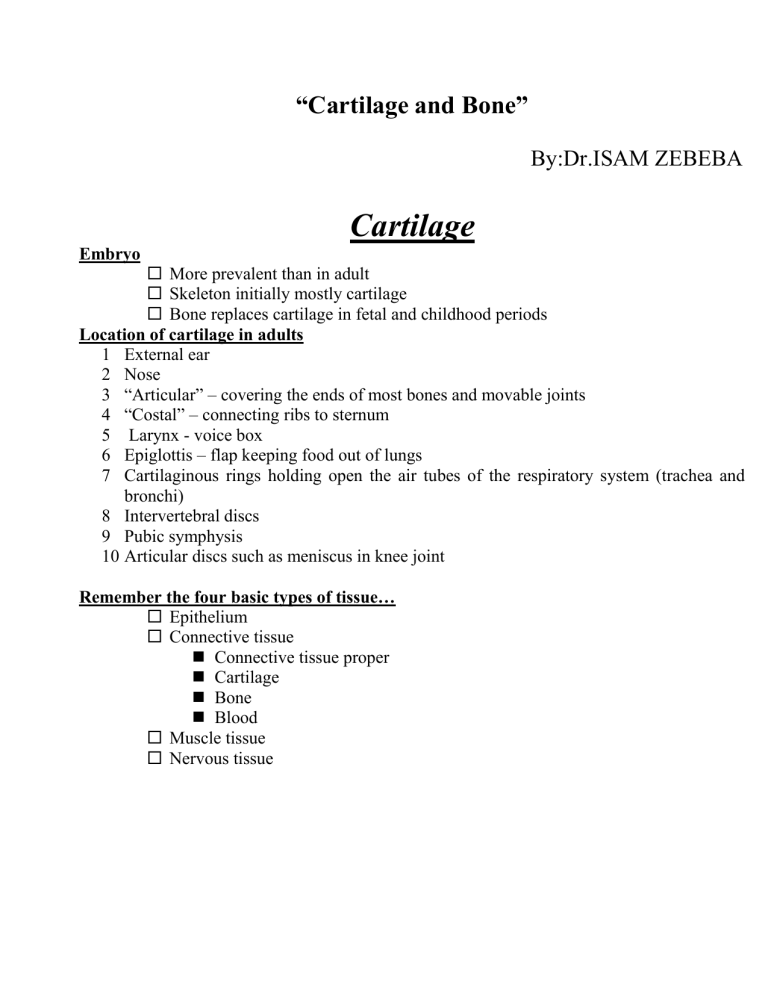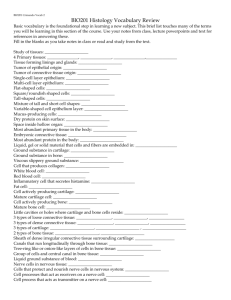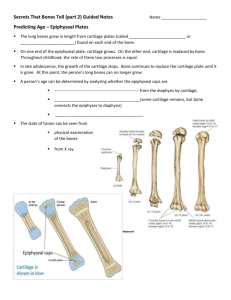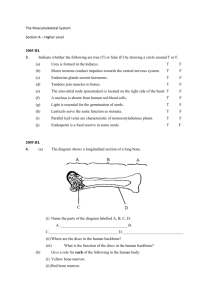eprint_11_29830_1347

“Cartilage and Bone”
By:Dr.ISAM ZEBEBA
Cartilage
Embryo
More prevalent than in adult
Skeleton initially mostly cartilage
Bone replaces cartilage in fetal and childhood periods
Location of cartilage in adults
1 External ear
2 Nose
3
“Articular” – covering the ends of most bones and movable joints
4
“Costal” – connecting ribs to sternum
5 Larynx - voice box
6 Epiglottis – flap keeping food out of lungs
7 Cartilaginous rings holding open the air tubes of the respiratory system (trachea and bronchi)
8 Intervertebral discs
9 Pubic symphysis
10 Articular discs such as meniscus in knee joint
Remember the four basic types of tissue…
Epithelium
Connective tissue
Connective tissue proper
Cartilage
Bone
Blood
Muscle tissue
Nervous tissue
Cartilage is connective tissue
1 Cells called chondrocytes
2 Abundant extracellular matrix
Fibers: collagen & elastin
Jellylike ground substance of complex sugar molecules
60-80% water (responsible for the resilience)
No nerves or vessels
Types of cartilage: 3
1.
Hyaline cartilage: flexible and resilient
Chondrocytes appear spherical
Lacuna – cavity in matrix holding chondrocyte
Collagen the only fiber
2.
Elastic cartilage: highly bendable
Matrix with elastic as well as collagen fibers
Epiglottis, larynx and outer ear
3.
Fibrocartilage: resists compression and tension
Rows of thick collagen fibers alternating with rows of chondrocytes (in matrix)
Knee menisci and annunulus fibrosis of intervertebral discs
Hyaline Cartilage
Elastic Cartilage
Fibrocartilage
1
2
3
Hyaline cartilage
: flexible and resilient
Chondrocytes appear spherical
4
Lacuna – cavity in matrix holding chondrocyte
Collagen the only fiber
Elastic cartilage
: highly bendable
Matrix with elastic as well as collagen fibers
Epiglottis and larynx
5
Fibrocartilage
: resists compression and tension
Rows of thick collagen fibers alternating with rows of chondrocytes (in matrix)
Knee menisci and annulus fibrosis of intervertebral discs
Growth of cartilage
1.
Appositional
“Growth from outside”
Chrondroblasts in perichondrium (external covering of cartilage) secrete matrix
2.
Interstitial
“Growth from within”
Chondrocytes within divide and secrete new matrix
1 Cartilage stops growing in late teens (chrondrocytes stop dividing)
2 Regenerates poorly in adults
Bones
1 Functions
1. Support
2. Movement: muscles attach by tendons and use bones as levers to move body
3. Protection
1. Skull – brain
2. Vertebrae – spinal cord
3. Rib cage – thoracic organs
4. Mineral storage
1. Calcium and phosphorus
2. Released as ions into blood as needed
5. Blood cell formation and energy storage
1. Bone marrow: red makes blood, yellow stores fat
Classification of bones by shape
1.
Long bones
2.
Short bones
3.
Flat bones
4.
Irregular bones
5.
Pneumatized bones
6.
Sesamoid bones
Gross anatomy of bones
1.
Compact bone
2.
Spongy (trabecular) bone
1 Blood vessels
2 Medullary cavity
3 Membranes
1. Periosteum
2. Endosteum
Flat bones
1 Spongy bone is called diploe when its in flat bones
Have bone marrow but no marrow cavity
Long bones
1 Tubular diaphysis
or shaft
1 Epiphyses at the ends: covered with “articular” (=joint) cartilage
2 Epiphyseal line in adults
Kids: epiphyseal growth plate (disc of hyaline cartilage that grows to lengthen the bone)
3 Blood vessels
Nutrient arteries and veins through nutrient foramen
Periosteum
1 Connective tissue membrane
2 Covers entire outer surface of bone except at epiphyses
3 Two sublayers
1. Outer fibrous layer of dense irregular connective tissue
2. Inner (deep) cellular osteogenic layer on the compact bone containing osteoprogenitor cells (stem cells that give rise to osteoblasts)
Osteoblasts : bone depositing cells
Also osteoclasts : bone destroying cells (from the white blood cell line)
4
Secured to bone by perforating fibers (Sharpey’s fibers)
Endosteum
1 Covers the internal bone surfaces
2 Is also osteogenic
Spongy bone
Spongy bone
1 Layers of lamellae and osteocytes
2 Seem to align along stress lines
Compact bone
1 Osteons: pillars
2 Lamellae: concentric tubes
3 Haversian canals
Osteocytes
Factors regulating bone growth
1 Vitamin D: increases calcium from gut
2 Parathyroid hormone (PTH): increases blood calcium (some of this comes out of bone)
3 Calcitonin: decreases blood calcium (opposes PTH)
4 Growth hormone & thyroid hormone: modulate bone growth
5 Sex hormones: growth spurt at adolescense and closure of epiphyses
Terms (examples)
1 chondro refers to cartilage
chondrocyte
endochondral
perichondrium
2 osteo refers to bone
osteogenesis
osteocyte
periostium
3 blast refers to precursor cell or one that produces something
osteoblast
4 cyte refers to cell
osteocyte
1.
Intramembranous Ossification a. Forms flat bones of skull, mandible, clavicle b. Replacement of mesenchymal membrane with osseous tissue c. Mesenchymal cells differentiate to osteoprogenitor cells, which then become osteoblasts d. Osteoblasts create spongy bone, which then remodels into compact bone where necessary
2.Endochondral Ossification
Mesenchyme creates Cartilage model, which gets replaced by bone
Replacement begins in middle (diaphysis) & follows in ends (epiphyses)
A)Cartilage model grows in length ( interstitial growth) & in width ( appositional growth)
Chondrocytes at the center of the growing cartilage model enlarge and then die as the matrix calcifies.
B)Newly derived osteoblasts cover the shaft of the cartilage in a thin layer of bone.
The perichondrium , which surrounded the cartilage model, now must be referred to as the periosteum .
C) Blood vessels penetrate the cartilage. New osteoblasts form a primary ossification center.
D) Bone tissue continues to replace cartilage of the diaphysis, and & continues toward each epiphysis.
The medullary cavity begins to hollow out Blood vessels invade the epiphyses and osteoblasts form secondary centers of ossification.
Cartilage remains only at the ends (articular cartilage) & at metaphysis (epiphyseal plate)
Organization of cartilage within the epiphyseal plate of a growing long bone








